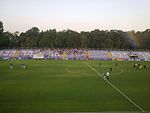Ramat Gan Safari

The Zoological Center Tel Aviv-Ramat Gan (commonly known as the Safari Ramat Gan) in the Tel Aviv District city of Ramat Gan, Israel is the largest collection of wildlife in human care in the Middle East. The 250-acre site consists of both a drive-through African safari area and a modern outdoor zoo. The African animal park opened to the general public in 1974. In 1981, the zoo was established in the middle of the park to replace the Tel Aviv Zoo, which had closed down. Ramat Gan Safari houses 83 species of mammals, 92 species of birds and 23 species of reptiles. Among other outstanding groups of animals, it has white rhinos, hippos, lions, African and Asian elephants, gorillas, orangutans, and a Komodo dragon. The animals are seen in open air enclosures amid subtropical gardens. The Ramat Gan Safari has sent animals to the Qalqilya Zoo in the West Bank of the Palestinian territories and maintains close ties with the veterinarians in the Palestinian Authority.It has more than 700,000 visitors annually from all social and ethnic groups of Israel as well as tourists from abroad.
Excerpt from the Wikipedia article Ramat Gan Safari (License: CC BY-SA 3.0, Authors, Images).Ramat Gan Safari
Naomi Shemer Memorial Trail,
Geographical coordinates (GPS) Address Phone number Website External links Nearby Places Show on map
Geographical coordinates (GPS)
| Latitude | Longitude |
|---|---|
| N 32.045 ° | E 34.825 ° |
Address
הספארי ברמת גן
Naomi Shemer Memorial Trail
5223403
Tel Aviv District, Israel
Open on Google Maps










